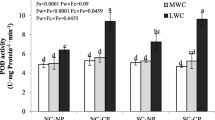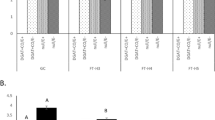Abstract
Autotoxicity and allelopathy affect the yield of GL66 and GL72, two populations of perennial ryegrass (Lolium perenne L. cv. S23) that were originally selected for contrasting rates of mature leaf dark respiration, but under conditions where allelopathic effects could not occur and autotoxic effects were minimal. To investigate if the respiration properties are also affected, the populations were subjected to two conditions (monoculture and mixed culture) and two treatments (grown in `renewed', i.e. solution completely replaced every week, and `replenished', i.e. nutrients added to the solution every week, to compensate for the nutrients that had been absorbed from the solution). When plants were grown in mixed culture with a `renewed' nutrient solution, the rate of mature leaf respiration in the absence of inhibitors was higher in GL66 than in GL72. In GL66, this rate was unaffected by condition or treatment, whereas in GL72 it increased in the `replenished' cultures, due to autotoxic and allelopathic effects. In contrast with GL66, for GL72 the effect of an inhibitor of the alternative path (salicylhydroxamic acid, SHAM) differed between conditions and treatments. Effects of an inhibitor of the cytochrome path (KCN) were affected by treatment in both populations. The increase in the rate of root respiration of GL66 due to autotoxic and allelopathic effects was accompanied by a higher rate of the SHAM-resistant component, i.e. maximum activity of the cytochrome path. Roots of GL72 showed a higher control respiration rate and a higher rate of the SHAM-resistant component when long-term accumulation of root exudates was allowed to occur in mixed cultures (allelopathy). We conclude that allelochemicals can modify both leaf and root respiration and that there is no consistent correlation between yield and respiration for GL66 and GL72 in the present study. This shows that selection for low rates of mature leaf respiration is not an appropriate method to select for high-yielding cultivars in perennial ryegrass.
Similar content being viewed by others
References
Balke N E 1985 Effects of allelochemicals on mineral uptake and associated processes. In The Chemistry of Allelopathy. Ed. AC Thompson. pp 161–178. American Chemical Society, Washington DC
Cruz Ortega R, Anaya A L and Ramos, L 1988 Effects of allelopathic compounds of corn pollen on respiration and cell division of watermelon. J. Chem. Ecol. 14, 71–86.
Day D A, De Vos O C, Wilson D and Lambers H 1985 Regulation of respiration in the leaves of two Lolium perenne populations with contrasting mature leaf respiration rates and crop yields. Plant Physiol. 78, 678–683.
Day D A, Krab K, Lambers H, Moore A L, Siedow J N, Wagner A M and Wiskich J T 1996 The Cyanide-resistant oxidase: To inhibit or not to inhibit, that is the question. Plant Physiol. 110, 1–2.
Greimel A and Koch H 1977 Taxifolin als Stimulator von Wachstum und Atmung der Pflanzen. Biochem. Physiol. Pflanzen 171, 419–423.
Guy R D, Berry J A, Fogel M L, Turpin D H and Weger H G 1992 Fractionation of the stable isotopes of oxygen during respiration by plants – the basis of a new technique to estimate partitioning to the alternative path. In Plant Respiration. Molecular, Biochemical and Physiological Aspects. Eds. H Lambers and LHW Van Der Plas. pp 443–453. SPB Academic Publishing, The Hague.
Kraus E 1992 The absence of a consistent relation between yield and the rate of dark respiration in selected populations of perennial ryegrass. In Molecular, Biochemical and Physiological Aspects of Plant Respiration. Eds. H Lambers and LHW Van Der Plas. pp 567–571. SPB Academic Publishing, The Hague.
Kraus E 1995 Yield and respiration of populations of Lolium perenne as affected by plant growth conditions. PhD Thesis, Utrecht University, Utrecht, the Netherlands.
Kraus E, Wilson D, Robson M J and Pilbeam C J 1990 Respiration: correlation with growth rate and its quantitative significance for the net assimilation rate and biomass production. In Causes and Consequences of Variation in Growth Rate and Productivity of Higher Plants. Eds. H Lambers, ML Cambridge, H Konings and TL Pons. pp 187–198. SPB Academic Publishing, The Hague.
Kraus E, Aydemir Y, Duin S, Kollöffel C and Lambers H 1993 Yield advantage of a 'slow-’ over a ‘fast-'respiring population of Lolium perenne cv. S23 depends on plant density. New Phytol. 123, 39–44.
Kraus E, Kollöffel C and Lambers H 1994 The effect of handling on photosynthesis, transpiration, respiration, and nitrogen and carbohydrate content of populations of Lolium perenne. Physiol. Plant. 91, 631–638.
Lambers H, Van Der Werf A and Bergkotte M 1993 Assessment of the capacity and activity of the alternative respiratory pathway in intact tissues. In Methods in Comparative Plant Ecology – A Laboratory Manual. Eds. GAF Hendry and JP Grime. pp 140–144. Chapman and Hall, London.
Lambers H, Chapin FS III & Pons TL 1998 Plant Physiological Ecology. Springer-Verlag, New York.
Møller I M, Bérczi A, Van Der Plas L H W and Lambers H 1988 Measurement of the activity and capacity of the alternative pathway in intact plant tissues: Identifications of problems and possible solutions. Physiol. Plant. 72, 642–649.
Politycka B and Wójcik-Wojtkowiak D 1991 Response of sweet pepper to phenols accumulated in greenhouse substrate. Plant Soil 135, 275–282.
Rainey D Y, Mitton J B, Monson R K and Wilson D 1990. Effects of selection for dark respiration rate on enzyme genotypes in Lolium perenne. Ann. Bot. 66, 649–654.
Rasmussen J A, Hejl A M, Einhellig F A and Thomas J A 1992 Sorgoleone from root exudate inhibits mitochondrial functions. J. Chem. Ecol. 18, 197–207.
Vaughan D and Ord B G 1991 Extraction of potential allelochemicals and their effect on root morphology and nutrient content. In Plant Root Growth. An Ecological Perspective. Ed. D Atkinson. pp 399–421. Blackwell Scientific Publication, Oxford.
Van Der Werf A, Welschen R and Lambers H 1992 Respiratory losses increase with decreasing inherent growth rate of a species and with decreasing nitrate supply: A search for explanations for these observations. In Molecular, Biochemical and Physiological Aspects of Plant Respiration. Eds. H Lambers and LHW Van Der Plas. pp 421–433. SPB Academic Publishing, The Hague.
Wilson D 1975 Variation in leaf respiration in relation to growth and photosynthesis of Lolium. Ann. Appl. Biol. 80, 323–338.
Wilson D 1982 Response to selection for dark respiration rate of mature leaves in Lolium perenne and its effects on growth of young plants and simulated swards. Ann. Bot. 49, 303–312.
Author information
Authors and Affiliations
Rights and permissions
About this article
Cite this article
Kraus, E., Lambers, H. Leaf and root respiration of Lolium perenne populations selected for contrasting leaf respiration rates are affected by intra- and interpopulation interactions. Plant and Soil 231, 267–274 (2001). https://doi.org/10.1023/A:1010336632553
Issue Date:
DOI: https://doi.org/10.1023/A:1010336632553




